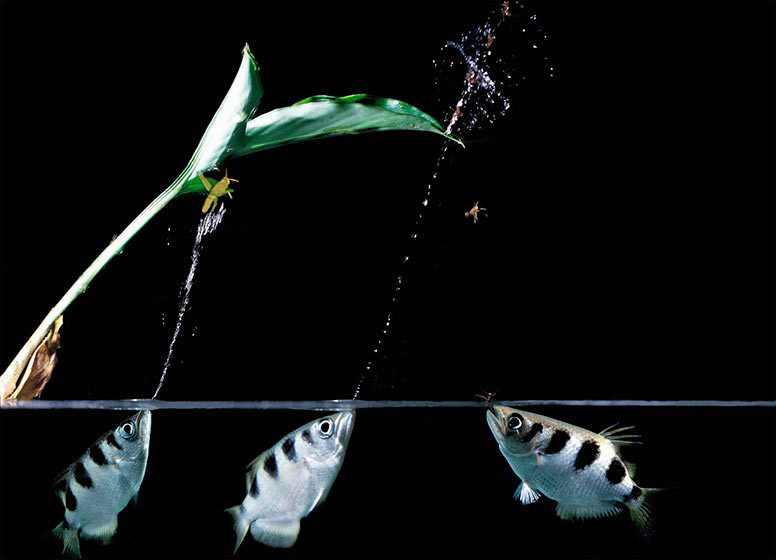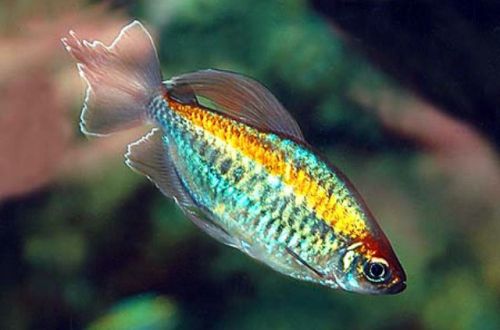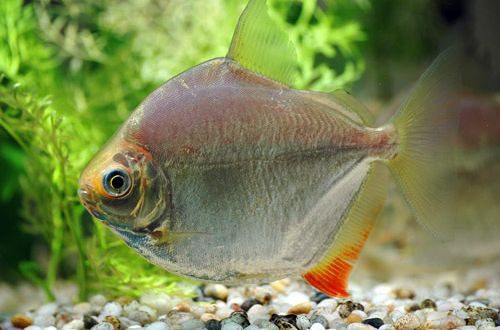
Sprayer fish
The Striped Archer, Banded Archer or Fish Archer, scientific name Toxotes jaculatrix, belongs to the Perciformes (Perch-like) family. The fish has an unusual way of feeding, knocking down insects above the surface with a jet of water. It is this feature that has made it popular. In addition, the Archer has become the object of scientific research with intriguing results, which were published in one of the most authoritative publications, Nature.
Contents
Habitat
This species has a wide distribution range. Wild representatives of the Striped archer have been found in India, throughout Southeast Asia. On the archipelagos between Asia and Australia, in particular in the Philippines, Micronesia, Palau, Indonesia, Solomon Islands, Papua New Guinea, Vanuatu.
Due to such a wide distribution, the natural environment is very diverse, fish are found in freshwater rivers, lakes and ponds, as well as in brackish coastal waters, mangrove swamps and estuaries. They prefer shaded regions with low overhanging vegetation.
Description
Adult individuals reach a length of about 30 cm. In an aquarium, they grow somewhat less. Sexual dimorphism is weakly expressed, it is rather problematic to distinguish a male from a female. The fish have a laterally flattened body, the fins are shifted closer to the tail. A characteristic feature of the species are large eyes and mouth. The coloration is silvery with a dark back and wide markings.
Food
Archer fish preys on insects
 A spatter fish shoots a stream of water at a leaf with an insect, knocks it down and eats it from the surface of the water.
A spatter fish shoots a stream of water at a leaf with an insect, knocks it down and eats it from the surface of the water.
Belongs to carnivorous species, feeds on both terrestrial and aquatic invertebrates. On occasion, they can eat small fish. The Banded Archer has an amazing hunting technique that has been featured in BBC and National Geographic sci-fi films more than once. Thanks to its large eyes, the fish is able to find insects that are above the water, for example, sitting on a tree cast not high from the surface. The structure of the mouth allows you to create a jet of water up to 1.5 meters high. The fish seems to spit water and knock down the insect, then it remains only to swallow it.
In a home aquarium, floating foods should be fed, such as dry food, frozen bloodworms, brine shrimp. If you have a paludarium, you can equip it in such a way that the Strider can shoot down some insects.

Maintenance and care, arrangement of the aquarium
It is permissible to keep the fish both in the aquarium and in the paludarium. The second option is preferable from the point of view of the natural way of feeding. The recommended volume of water starts from 500 liters for one adult. Water conditions should be brackish with a salt concentration of up to 15 grams. per liter of water. Internal current is minimal. The lighting is bright or moderate depending on the plants used. Any soil, because the striped archer lives closer to the surface, then the presence of a substrate is not of great importance for him. Numerous snags are also used in the design. In the case of a palludarium, overhanging vegetation is formed above the surface, on which future prey is subsequently placed.
When keeping this fish, the arrangement and maintenance of the aquarium is usually done by professionals, so this article provides only a minimum of information.
Behavior and Compatibility
In general, a peaceful calm fish, which, however, can eat smaller neighbors in the aquarium. Due to the special conditions of detention, the choice of compatible species is limited. Some Rainbows that can tolerate high salinity can be a good choice. Intraspecific relationships are built on the dominance of a stronger individual. It is advisable to maintain a group of at least 4-5 fish. With a smaller number, aggression is possible.
Breeding / breeding
At the time of this writing, there is no reliable information about the breeding of Spatter Fish in a home aquarium. In nature, they migrate to sea water for reproduction, it is very difficult to artificially recreate such conditions.





